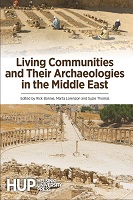Living Communities and Their Archaeologies in the Middle East
| dc.contributor.editor | Bonnie, Rick Gerard Lorenz Maria | |
| dc.contributor.editor | Lorenzon, Marta | |
| dc.contributor.editor | Thomas, Suzie | |
| dc.date.accessioned | 2023-10-09T09:35:32Z | |
| dc.date.available | 2023-10-09T09:35:32Z | |
| dc.date.issued | 2023 | |
| dc.identifier | OCN: 1402734886 | |
| dc.identifier.uri | https://library.oapen.org/handle/20.500.12657/76591 | |
| dc.description.abstract | This volume presents theoretical ideas, case studies, and reflective insights on community archaeology across the Middle East, with contributions by scholars working in and from Iraq, Israel, Jordan, Palestine, and Syria. The chapters represent a multitude of insights from contemporary public archaeology practice—drawing on theoretical frameworks and discussing the realities of challenges and opportunities presented by opening up archaeological experiences to wider publics in different social and political settings. In particular, the volume focuses on the following three themes: (1) defining and reflecting on ‘community’ in community archaeology; (2) which archaeologies to employ in community archaeology; and (3) measuring the success and failure of community archaeology. In addressing these issues, the chapters reflect different historical trajectories and cultures that enable us to find similarities and differences in the theory and practice of community archaeology. In more recent decades a shift has been noticed among both national authorities and foreign archaeological expeditions, with more emphasis on local heritage experiences. However, this frequently took the form of guiding and introducing communities to ‘their heritage’. Only more recently local voices have become more heard in definitions of heritage and decisions on preservation matters, with more projects tying these voices into their research objectives. This volume presents several projects that combine postcolonial approaches, citizen participation, and community work across the Middle East. By focusing especially on this geographical area, the volume also reflects upon the current state of public and community archaeology in this unique and complex region, adding to the already rich literature from the rest of the world. The Middle East has a long, fascinating, but also complicated history of archaeological investigation, deeply entrenched in colonization, and more recently in the decolonization process. The involvement and social values of the associated communities have often been overlooked in academic discussions. This book aims to redress that imbalance and present original research that reflects on the work of current scholars and practitioners and draws similarities and differences from diverse cultures. | en_US |
| dc.language | English | en_US |
| dc.subject.other | Middle East; public engagement; decolonization; Near Eastern archaeology; Western Asia archaeology; Community archaeology | en_US |
| dc.title | Living Communities and Their Archaeologies in the Middle East | en_US |
| dc.type | book | |
| oapen.identifier.doi | 10.33134/HUP-19 | en_US |
| oapen.relation.isPublishedBy | 20cefb8d-481a-4a27-af02-aec9567fecb5 | en_US |
| oapen.relation.isbn | 9789523690875 | en_US |
| oapen.relation.isbn | 9789523690851 | en_US |
| oapen.pages | 289 | en_US |
| oapen.place.publication | Helsinki | en_US |

